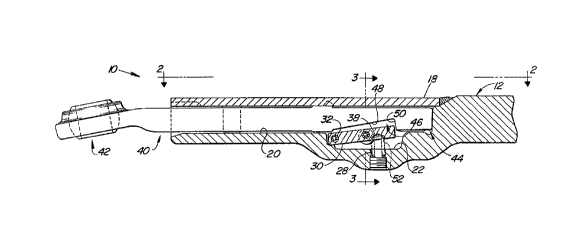Some of the information on this Web page has been provided by external sources. The Government of Canada is not responsible for the accuracy, reliability or currency of the information supplied by external sources. Users wishing to rely upon this information should consult directly with the source of the information. Content provided by external sources is not subject to official languages, privacy and accessibility requirements.
Any discrepancies in the text and image of the Claims and Abstract are due to differing posting times. Text of the Claims and Abstract are posted:
| (12) Patent: | (11) CA 2114062 |
|---|---|
| (54) English Title: | EXTENDABLE LATCHABLE DRAFT LINK |
| (54) French Title: | ATTELAGE TELESCOPIQUE VERROUILLABLE |
| Status: | Deemed expired |
| (51) International Patent Classification (IPC): |
|
|---|---|
| (72) Inventors : |
|
| (73) Owners : |
|
| (71) Applicants : |
|
| (74) Agent: | BORDEN LADNER GERVAIS LLP |
| (74) Associate agent: | |
| (45) Issued: | 1997-12-30 |
| (22) Filed Date: | 1994-01-24 |
| (41) Open to Public Inspection: | 1994-07-28 |
| Examination requested: | 1994-01-24 |
| Availability of licence: | N/A |
| (25) Language of filing: | English |
| Patent Cooperation Treaty (PCT): | No |
|---|
| (30) Application Priority Data: | ||||||
|---|---|---|---|---|---|---|
|
A telescoping draft link assembly includes a hollow first
tractor-coupled link and a second implement-coupled link
slidably received by a channel in the first link. A pocket is
formed in the first link next to the channel. A plate is
pivotally mounted in the pocket and is pivotal from a release
position wherein the plate is entirely received in the pocket
to a locking position wherein at least a portion of the plate
projects into the channel. The second link has a notch formed
therein, an end of the notch forming a shoulder which is
engageable with the plate to releasably hold the second link
in the retracted position. A spring is biased to urge the
plate towards its locking position and a knob is attached to
the plate so that an operator may pivot the plate to a release
position.
Assemblage de pièces de traction télescopique comportant un premier élément creux rattaché au tracteur et un deuxième élément relié à l'engin remorqué qui peut s'insérer par glissement dans un canal du premier élément. Une plaque est montée dans un logement contigu au canal. Cette plaque est en mesure de tourner d'une position de dégagement, pour laquelle cette plaque est entièrement située dans le logement, à une position de verrouillage, pour laquelle une partie au moins de la plaque dépasse dans le canal. Le deuxième élément comporte une encoche, une extrémité de cette encoche formant un épaulement susceptible de s'engager avec la plaque pour maintenir le deuxième élément en position rétractée jusqu'à ce que la plaque soit dégagée. Un ressort comprimé oblige la plaque à conserver sa position de verrouillage et un bouton, fixé à la plaque, permet à un opérateur de faire tourner la plaque en position de dégagement.
Note: Claims are shown in the official language in which they were submitted.
Note: Descriptions are shown in the official language in which they were submitted.

For a clearer understanding of the status of the application/patent presented on this page, the site Disclaimer , as well as the definitions for Patent , Administrative Status , Maintenance Fee and Payment History should be consulted.
| Title | Date |
|---|---|
| Forecasted Issue Date | 1997-12-30 |
| (22) Filed | 1994-01-24 |
| Examination Requested | 1994-01-24 |
| (41) Open to Public Inspection | 1994-07-28 |
| (45) Issued | 1997-12-30 |
| Deemed Expired | 2005-01-24 |
There is no abandonment history.
| Fee Type | Anniversary Year | Due Date | Amount Paid | Paid Date |
|---|---|---|---|---|
| Application Fee | $0.00 | 1994-01-24 | ||
| Registration of a document - section 124 | $0.00 | 1994-07-29 | ||
| Maintenance Fee - Application - New Act | 2 | 1996-01-24 | $100.00 | 1996-01-23 |
| Maintenance Fee - Application - New Act | 3 | 1997-01-24 | $100.00 | 1997-01-23 |
| Final Fee | $300.00 | 1997-09-10 | ||
| Maintenance Fee - Patent - New Act | 4 | 1998-01-26 | $100.00 | 1998-01-23 |
| Maintenance Fee - Patent - New Act | 5 | 1999-01-25 | $150.00 | 1999-01-22 |
| Maintenance Fee - Patent - New Act | 6 | 2000-01-24 | $150.00 | 2000-01-21 |
| Maintenance Fee - Patent - New Act | 7 | 2001-01-24 | $150.00 | 2001-01-23 |
| Maintenance Fee - Patent - New Act | 8 | 2002-01-24 | $150.00 | 2002-01-23 |
| Maintenance Fee - Patent - New Act | 9 | 2003-01-24 | $150.00 | 2003-01-23 |
Note: Records showing the ownership history in alphabetical order.
| Current Owners on Record |
|---|
| DEERE & COMPANY |
| Past Owners on Record |
|---|
| BREMNER, RONALD DEAN |